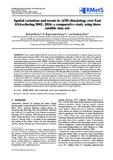| dc.description.abstract | Aerosol optical depth (AOD) has become one of the most crucial parameters for climate change assessment.
This study presents long-term (2002–2016) spatio-temporal distributions and trends in AOD over East Africa (EA) retrieved
from the moderate-resolution imaging spectroradiometer (MODIS) Aqua [Dark Target (DT) and Deep Blue (DB)] and
multi-angle imaging spectroradiometer (MISR). An inter-comparison of AODs retrieved from different algorithms noticed
significant positive correlations (r =0.72−0.87) with MISR underestimating MODIS. Moderate (>0.5–0.8) to high (≥0.8)
correlations in AOD exhibited over EA, with a few regions representing low (0–0.5) positive correlations. The spatial patterns
of annual mean AOD were generally characterized by low (<0.2), moderate (0.2–0.35) and high (>0.35) centres over EA.
The seasonal mean AODs over EA were found high (low) during the local dry (wet) seasons, with annual mean (±𝜎) values
of 0.20±0.01, 0.18±0.01 and 0.20±0.02 as observed by DT, DB and MISR, respectively. A single peak distribution of
frequencies in AOD was observed by the three sensors in the interval 0.1–0.2, signifying a generally less polluted environment dominated by particular aerosol type. Linear trend analysis revealed an increase in AOD by 0.52, 0.57 and 0.74% year−1 as detected by MISR, DT and DB, respectively, and were consistent with those noted in key meteorological parameters.Furthermore, annual and seasonal spatial trends and tendencies revealed a general increase in AOD over EA, being positive and significant over the northern part of EA. Later, classification of major aerosol types over major cities in EA revealed dominance of continental (74.47%) followed by the mixed (16.22%) and biomass-burning/urban-industrial (8.02%) aerosols, with minor contributions from desert dust (1.03%) and clean maritime (0.32%) type of aerosols. | en_US |

